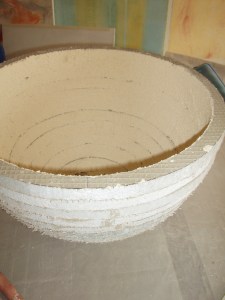I often work in collaboration with Peinture Fischer, a French company specialising in 100% natural decorative products of their own fabrication in Rosheim, a medieval town in Alsace.
Our latest project together involved creating a wash basin, stand and soap dish with a tadelakt finish. Tadelakt is a lime plaster originating in Morocco and traditionally produced with lime from Marrakech. It has been used for thousands of years on interior and exterior walls due to its natural water resistance and beautifully polished finish. Tadelakt is an extremely time consuming and laborious product to work with. As with most natural materials it reacts differently depending on the surface, humidity level, and ambient temperature. Professionals take years to master the art of applying such materials and to learn how to ‘listen’ to them. This was my first hands-on experience with tadelakt, so it is therefore challenging for me to describe the whole process in great depth. I have attempted to share my experience as best I can.
The first stage in making the wash basin was to create the initial shape by cutting out concentric rings of concrete coated polystyrene. I had to cut a total of 12 rings which proved challenging as the serrated blade on my hacksaw turned into a butter knife after cutting only two pieces – very impressive!

These were then glued together using masonry joint adhesive.



Once the masonry glue had hardened overnight the entire bowl was coated in Keim plaster, a mineral plaster that creates a porous surface for the tadelakt to adhere to.



Before receiving the tadelakt the surface must contain a certain level of humidity; this is achieved by dampening the bowl with a brush dipped in water. When the water has permeated the structure, the first layer (about 1mm) is applied over the entire surface. The second layer (usually around 5mm) is applied when most of the moisture has been absorbed.




The tadelakt must be left for a while to bond with it’s support before being smoothed out. Pressing on the surface with a plastic wedge brings the water to the surface. This is a very strange process as tadelakt often appears dry, but when the water comes to the surface it can be manipulated again and again. This must be done until all moisture has been absorbed and can take a while…

24 hours later, a soapy solution is applied with a brush and then worked in with a polishing stone. This solution will make the tadelakt water resistant; extremely important when used in a bathroom. Like with most natural plasters, there is a fine line between not manipulating enough and manipulating too much. Tadelakt is no different, polishing it is an art just like all the other steps.


The last stage will be completed in a few weeks time. The tadelakt has to “breathe” before being coated in bees’ wax and finished off with a buffing pad, just like polishing a car.
As well as making the wash basin, we also made the table stand for it. This was the same process, albeit using cellular concrete (for strength and stability) instead of polystyrene as the initial structure. Enjoying this project, I sculpted a soap dish out of the same material and applied the tadelakt to it too. This is likely one of the more expensive soap dishes ever made…
Enjoy the photos.



















